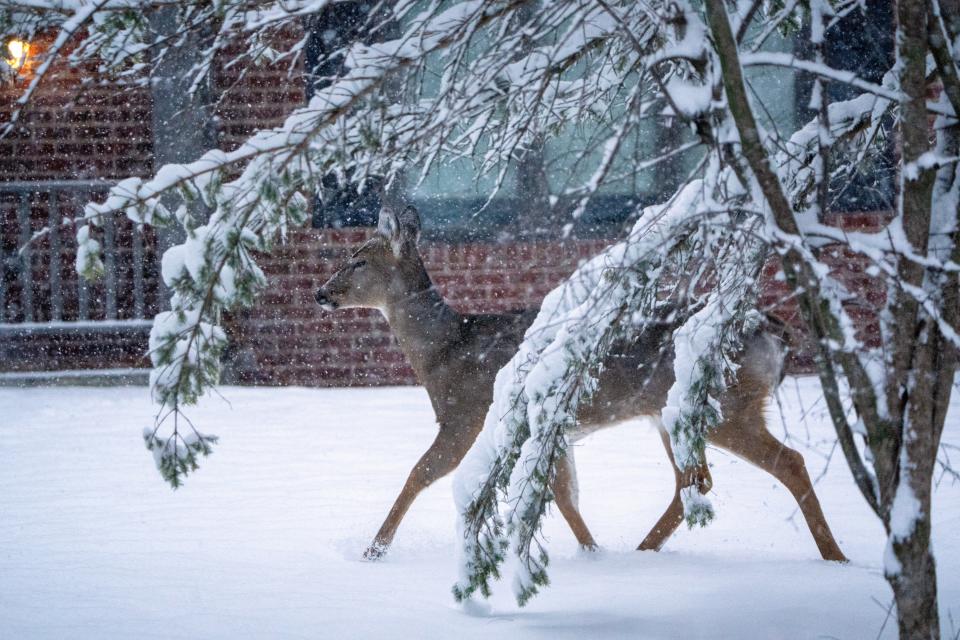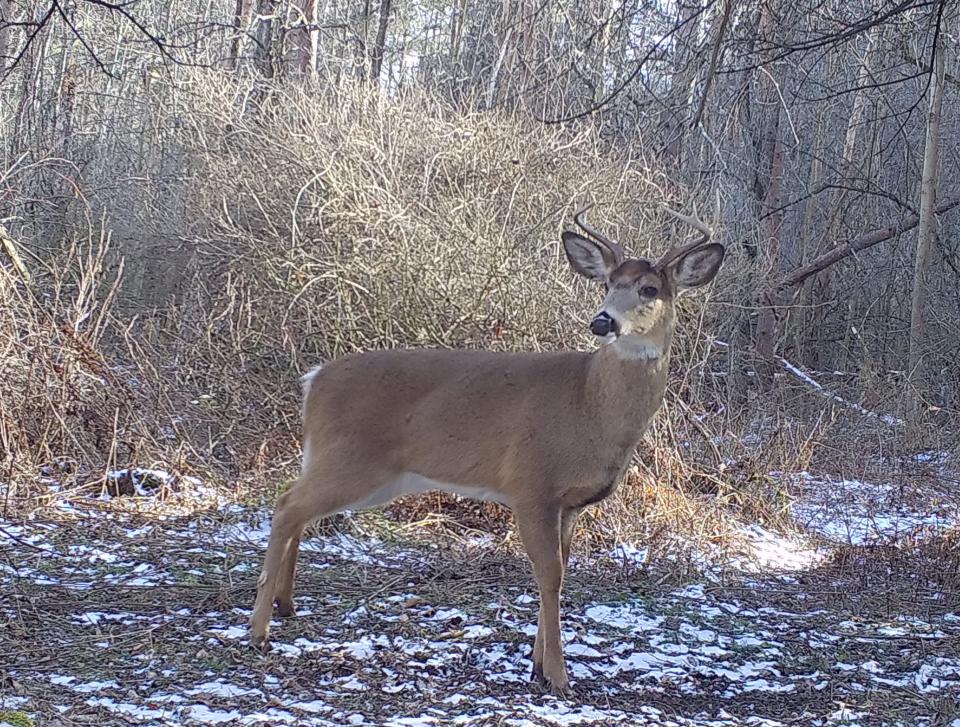Whitetails are moving into our yards. Could a change in state policy help keep them away?
Whitetail deer will seemingly eat and thrive on just about all plant material, from roots to stalks, stems and twigs, to leaves, flowers and fruit.
If it grows, they'll eat it.
Deer shy away from alliums, like garlic, chives and onions. But I have seen where they nip leeks in the woods. And they don’t like marigolds.
With our early spring, we had high hopes for the tulips out front. They were coming up nicely, but a few nights ago they were eaten down to ground level.
Too late to cover them up now.
Nature has built into the deer a food processing system that allows the whitetail to thrive where most other large herbivores would starve.
But deer pay a price for this extreme gastronomic utilitarianism. It takes a while for them to "gear up."
And as the deer population continues to get disproportionately denser closer to human habitation, here in the Southern Tier of New York state, their voracious nature will have an ever increasing and accelerated impact upon our woody plant and grass communities outside our front and back doors.
There is an answer. New York needs to amend its current ban on feeding deer supplements and allow conservationists to put food and minerals back in the woods so the deer stay there and not in the streets and backyards.
Deer go where they can shop for the best groceries.
But there's a catch. The whitetail's complex and highly efficient four-part alimentary processing system can’t change gears overnight. There is a necessary lag time in their ability to synthesize one food type and then shift to another.
Human beings, on the other hand, can jump from one type of food to another without missing a beat … if not a burp.

Whitetail stomachs, highly efficient bio-chemical engines, need to alter their chemicals, acids, enzymes and bacteria, in a gradual way to process their food. And nature coincides, whether it's domestic or wild, never producing or making available a crop all at once, but slow at first and then it peaks, like how apples and acorns fall, or the growth of grasses in springtime.
Whitetails that are fed corn and grains in the winter at feeders by biologists, studying behavior, have found that if the supplied food is terminated, deer have a difficult time sustaining their energy on available browse, or twigs. Evidently the bacteria and chemicals, the gut biomes in the deer's stomach, needs to "grow" into a new food source.
Whitetails starving from winter-kill in "yards" where they group when the snow is extremely deep in the north country have also been airlifted hay. The bales were dropped right in the deer-yard. But the deer still died. The scientific conclusion, after autopsies, is that they in fact starved to death with stomachs full of hay!
If it had been slowly introduced to them, say over a month's time, then they would have had a better chance at survival by being able to digest the airlifted hay.
Deer, as ruminants that chew a cud, seem to need a mix in their bellies. Even when the apples and acorns fall, whitetails still need to graze on grasses and browse woody stems.

One February I was surprised that the deer seemed to prefer the hemlock boughs I cut, trimming out a trail, over a bag of cob corn I had left at a turkey feeder. At first the gray squirrels thrived on the corn, but as time went on, subsequent visits to the trail showed an ever-increasing presence of deer, along with turkey to the corn in the feeder. But they still ate the fresh hemlock branches, as quickly as ever.
I think it is interesting to note in some of our remnant hemlock stands, it's difficult to find many small hemlock trees. That's only one obvious testament among countless others to the way the whitetail is shaping our woodlands. And as the woodlands mature, whitetails move closer to our homes.
Deer are experimental as well as adaptable. Deer have even learned to dig potatoes and eat pumpkins. Residential ornamental shrubs from Asia are becoming a favored winter food source, right next to a porch or window, evidently the more exotic and expensive, the more yummy to the whitetail.
More: Turkey decoy placement, setup: Tips to call in a gobbler this spring
Those whitetails that have over-browsed their woodlots in much of their range, and having gleaned most of the best and nutritious plant material, have no choice but to leave the deeper woods during the winter and invade our yards and plantings.
Whitetail hunters are learning that they do not have to go "way back in" to encounter deer any more. Matter of fact, areas in relatively close proximity to houses now sustain some of the highest densities of whitetails, not solely because of the relative sanctuary and safety, but because of the diversity and abundance of food.
The great paradox in deer management is becoming: How do we manage deer, keeping their population in harmony with man, if hunting near residences is excluded as a viable answer?
One answer might be if we could change the current New York state ban on feeding deer so we could supply them with a more healthy menu of mineral supplements and protein.
If the state DEC would get in line with other state game departments, all across the country, and allow those of us who care about whitetails to augment and enhance the deer's woodland cuisine and menu, our whitetails would once again be creatures of the woods and not so dense in our backyards and roadways.
— Oak Duke writes a weekly column.
This article originally appeared on The Evening Tribune: Deer are getting more bold visiting our lawns. Could this change help?

